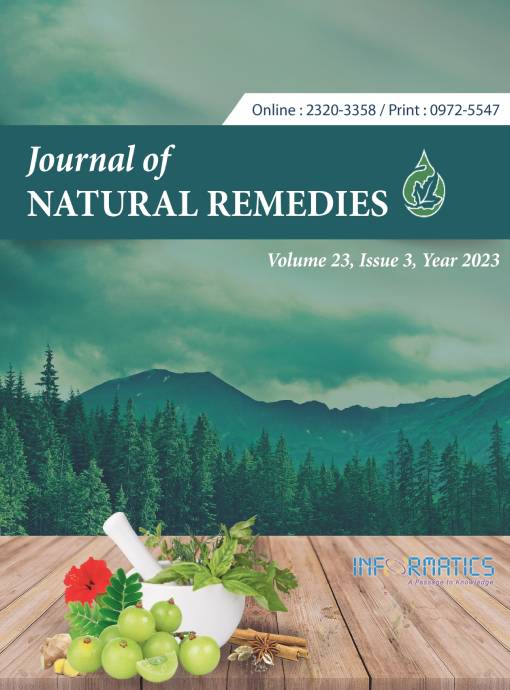Application of Quality Risk Assessment and Design of Experiment in Optimizing Chromatographic Method for Estimation of Total Sarsasapogenin from the Roots of Asparagus racemosus Wild
DOI:
https://doi.org/10.18311/jnr/2023/31865Keywords:
Asparagus racemosus, AQbD, HPTLC, Quality by Design, Quality Risk Management, SarsasapogeninAbstract
The roots of the plant Asparagus racemosus (Wild) (family: Liliaceae) are used alone as a lactogenic and general tonic or incorporated as a major ingredient in many herbal and Ayurveda formulations. Shatavarin glycosides containing sarsasapogenin as aglycone were found bioactive, and present in predominantly higher amount. The experiments were planned to develop an analytical method for estimation of total sarsasapogenin from the extract using HPTLC, through a systematic approach after identifying the potential failure modes, termed as critical process parameters to achieve the analytical target profile. The associated risks were mitigated by studying the combined effect of the critical process parameters on area, Rf, and tailing factor corresponding to the sarsasapogenin peak, assigned as critical method attributes. The optimization studies were carried out through Design of Experiment approach and process parameters were finalized to achieve analytical target profile. The developed method could resolve the peak of sarsasapogenin from the hydrolyzed methanolic extract prepared from the root powder using silica gel-backed pre-coated aluminum plates. The optimized mobile phase was Hexane:Ethyl acetate:Formic acid (7.0:1.9:0.35, v/v/v); the plates were subjected to post-chromatographic derivatization using 5% v/v hydrochloric acid solution, and heating of the plats for 3 min at 110˚C. The chromatogram was recorded by scanning the plates in TLC scanner using fluorescence mode at 366 nm. The developed analytical method was found to yield linear response in the range of 40-280 ng/spot. The limit of quantification was determined to be 35.88 ng/spot. The method was found selective, accurate, and robust. The amount of sarsasapogenin was found to be determined using the developed method and found to be 2.31% w/w on dried weight basis from the dried root powder. This is the first report of a systematic approach in estimating sarsasapogenin from Asparagus sp.
Downloads
Metrics
Downloads
Published
How to Cite
Issue
Section
License
Copyright (c) 2023 Hardi Shah, Priyanka Patel, Samir Patel, Manan Raval (Author)

This work is licensed under a Creative Commons Attribution 4.0 International License.
Accepted 2023-05-23
Published 2023-08-31
References
Singla R, Jaitak V. Shatavari (Asparagus racemosus Wild): A review on its cultivation, morphology, phytochemistry and pharmacological importance. Int J Pharm Sci Res. 2014; 5(3):742-57.
Singh L, Choudhary A, Singh G, Kumar A. Asparagus racemosus: The plant with immense medicinal potential. J Pharmacogn Phytochem. 2018; 7(3):2199- 203.
Sakharam BP, Gorakh MS, Prakash KB. An overview of Shatavari (Asparagus racemosus) an ayurvedic drug. Int J Ayurveda Pharma Res. 2019; 7(7):60-5. https://doi.org/10.47070/ijapr.v7i7.1256 DOI: https://doi.org/10.47070/ijapr.v7i7.1256
Sharma K, Bhatnagar M. Asparagus racemosus (Shatavari): A versatile female tonic. Int J Pharm Biol Arch. 2011; 2(3):855-63.
Singh B, Sharma RA. Secondary metabolites of medicinal plants; 2020. https://doi. org/10.1002/9783527825578 DOI: https://doi.org/10.1002/9783527825578
Alok S, Jain SK, Verma A, Kumar M, Mahor A, Sabharwal M. Plant profile, phytochemistry and pharmacology of Asparagus racemosus (Shatavari): A review. Asian Pacific J Trop Dis. 2013; 3(3):242-51. https://doi.org/10.1016/S2222-1808(13)60049-3 DOI: https://doi.org/10.1016/S2222-1808(13)60049-3
Ajitha S, Sharma DN. A comprehensive review of the pharmacological actions of Asparagus racemosus. Am J Pharmatech Rsearch. 2017; 7(February):1-20.
Gujarathi J, Gujarathi R. Shatavari - A boon for Women. 2014; (March 2010).
Hayes PY, Jahidin AH, Lehmann R, Penman K, Kitching W, De Voss JJ. Structural revision of shatavarins I and IV, the major components from the roots of Asparagus racemosus. Tetrahedron Lett. 2006; 47(39):6965-9. https://doi.org/10.1016/j.tetlet.2006.07.121 DOI: https://doi.org/10.1016/j.tetlet.2006.07.121
Venkatesan N, Thiyagarajan V, Narayanan S, Arul A, Raja S, Kumar SGV, et al. Anti-diarrhoeal potential of Asparagus racemosus wild root extracts in laboratory animals. J Pharm Pharm Sci. 2005; 8(1):39-45.
Visavadiya NP, Narasimhacharya AVRL. Asparagus root regulates cholesterol metabolism and improves antioxidant status in hypercholesteremic rats. Evidence-based Complement Altern Med. 2009; 6(2):219-26. https://doi.org/10.1093/ecam/nem091 DOI: https://doi.org/10.1093/ecam/nem091
Bopana N, Saxena S. Asparagus racemosus—Ethnopharmacological evaluation and conservation needs. J Ethnopharmacol. 2007; 110(1):1-15. https://doi. org/10.1016/j.jep.2007.01.001 DOI: https://doi.org/10.1016/j.jep.2007.01.001
Sekine T, Fukasawa N, Kashiwagi Y, Ruangrungsi N, Murakoshi I. Structure of asparagamine A: A novel polycyclic alkaloid from Asparagus racemosus. Chem Pharm Bull. 1994; 42:1360-2. https://doi.org/10.1248/ cpb.42.1360 DOI: https://doi.org/10.1248/cpb.42.1360
Negi J, Singh P, Joshi G, Rawat M, Bisht V. Chemical constituents of Asparagus. Pharmacogn Rev. 2010; 4(8):215-20. https://doi.org/10.4103/0973- 7847.70921 DOI: https://doi.org/10.4103/0973-7847.70921
Chawla A, Chawla P, Roy RC. Asparagus racemosus (Willd): Biological Activities and its active principles. Indo-Global J Pharm Sci. 2011; 1(2):113-20. https:// doi.org/10.35652/IGJPS.2011.11 DOI: https://doi.org/10.35652/IGJPS.2011.11
Haghi G, Hatami A, Mehran M. Determination of Shatavarin IV in root extracts of Asparagus racemosus by HPLC-UV. Anal Chem Lett. 2012; 2(1):1-6. https:// doi.org/10.1080/22297928.2012.10648246 DOI: https://doi.org/10.1080/22297928.2012.10648246
Negi JS, Singh P, nee Pant GJ, Rawat MS. High performance liquid chromatographic analysis of derivatized sapogenin of Asparagus (RP-HPLC analysis of derivatized sapogenin of Asparagus). J Med Plant Res. 2011; 5(10):1900-4. https://doi. org/10.4103/0973-7847.91109 DOI: https://doi.org/10.4103/0973-7847.91109
Yang B, Liu Z, Hu J, Lai X, Xia P. Quantitative determination of sarsasapogenin in rat plasma using liquid chromatography-tandem mass spectrometry. J Chromatogr B. 2016; 1022:213-9. https://doi. org/10.1016/j.jchromb.2016.04.020 DOI: https://doi.org/10.1016/j.jchromb.2016.04.020
Shah PM, Singh R, Dhanani T, Kumar S. Variation of saponin content in Asparagus adscendens germplasms from Western Himalayan Region of India using high performance liquid chromatography-evaporative light scattering detector. J Pharm Appl Chem. 2018; 1; 4(1):60-6. https://doi.org/10.18576/jpac/040209 DOI: https://doi.org/10.18576/jpac/040209
Peraman R, Bhadraya K, Reddy YP. Analytical quality by design: A tool for regulatory flexibility and robust analytics. Int J of Analytical Chem. 2015, p. 1–9. https://doi.org/10.1155/2015/868727 DOI: https://doi.org/10.1155/2015/868727

 Hardi Shah
Hardi Shah









 0.35
0.35 24
24 0.161
0.161